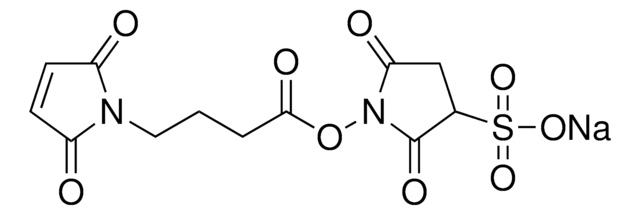63179
3-(Maleimido)propionic acid N-hydroxysuccinimide ester
≥98.5% (HPLC)
Synonyme(s) :
3-(Maleimido)propionic acid N-succinimidyl ester, BMPS, N-(3-Maleimidopropionyloxy)succinimide, N-Maleoyl-β-alanine N′-hydroxysuccinimide ester, N-Succinimidyl 3-maleimidopropionate
About This Item
Produits recommandés
Niveau de qualité
Essai
≥98.5% (HPLC)
Forme
solid
Pertinence de la réaction
reagent type: linker
Pf
167-171 °C
Groupe fonctionnel
NHS ester
Température de stockage
2-8°C
Chaîne SMILES
O=C1CCC(N1OC(CCN2C(C=CC2=O)=O)=O)=O
InChI
1S/C11H10N2O6/c14-7-1-2-8(15)12(7)6-5-11(18)19-13-9(16)3-4-10(13)17/h1-2H,3-6H2
Clé InChI
JKHVDAUOODACDU-UHFFFAOYSA-N
Vous recherchez des produits similaires ? Visite Guide de comparaison des produits
Catégories apparentées
Application
Code de la classe de stockage
11 - Combustible Solids
Classe de danger pour l'eau (WGK)
WGK 3
Point d'éclair (°F)
Not applicable
Point d'éclair (°C)
Not applicable
Équipement de protection individuelle
dust mask type N95 (US), Eyeshields, Gloves
Faites votre choix parmi les versions les plus récentes :
Déjà en possession de ce produit ?
Retrouvez la documentation relative aux produits que vous avez récemment achetés dans la Bibliothèque de documents.
Les clients ont également consulté
Notre équipe de scientifiques dispose d'une expérience dans tous les secteurs de la recherche, notamment en sciences de la vie, science des matériaux, synthèse chimique, chromatographie, analyse et dans de nombreux autres domaines..
Contacter notre Service technique









![O-[N-(3-Maleimidopropionyl)aminoethyl]-O′-[3-(N-succinimidyloxy)-3-oxopropyl]triethylene glycol ≥90% (NMR)](/deepweb/assets/sigmaaldrich/product/structures/328/004/054496e8-534d-44d8-a8d7-b85d6377947e/640/054496e8-534d-44d8-a8d7-b85d6377947e.png)

